Tips for Telescope-buying, Jupiter Sports Great Spots, Mars in Morning, and Night’s Brightest Lights!
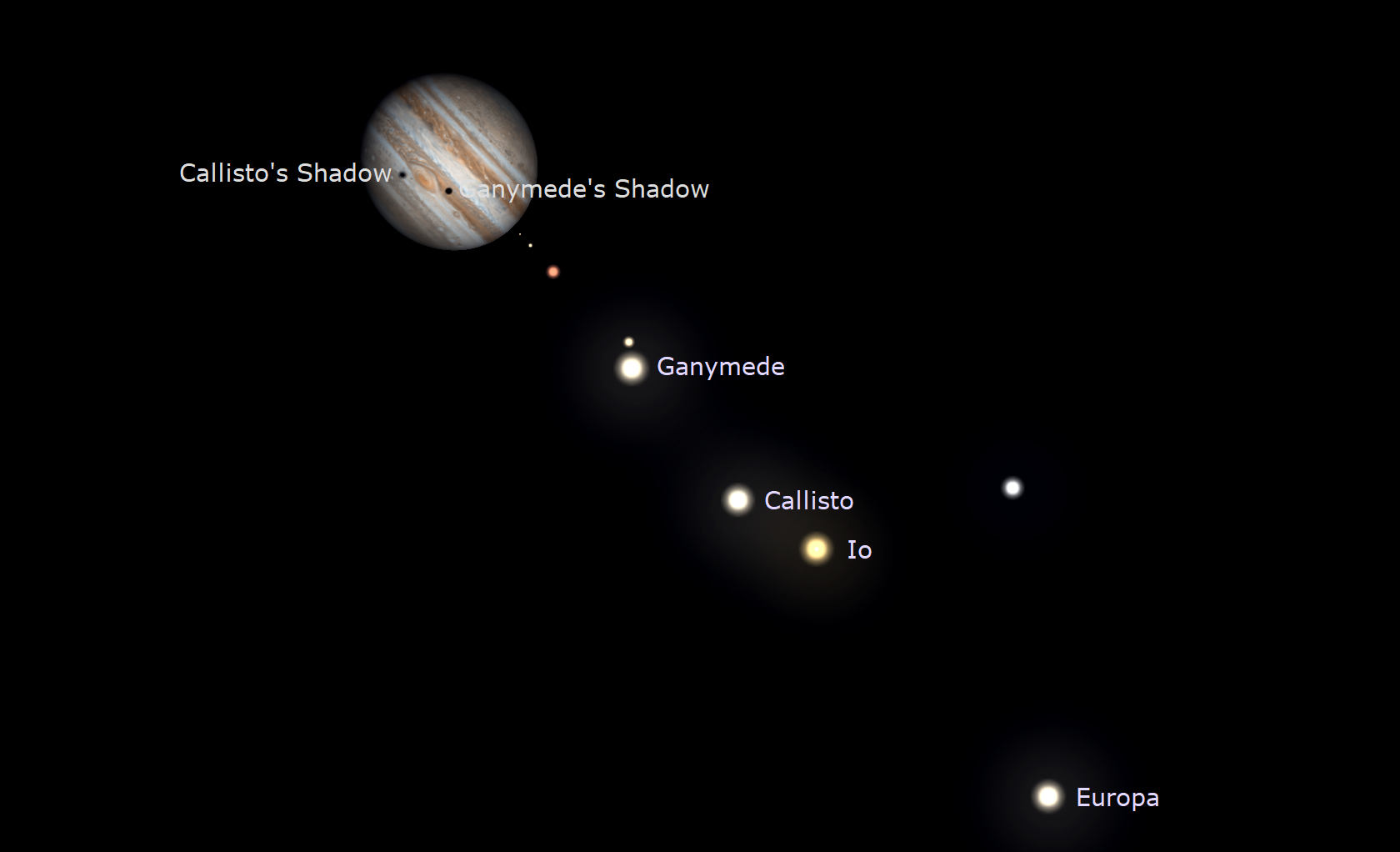
On Tuesday evening November, 23, observers in the Americas with telescopes can view a rare treat when the shadows of Ganymede and Callisto traverse Jupiter, accompanied by the Great Red Spot, as shown here for 8 pm EST
Hello, late-November Stargazers!
Here are your Astronomy Skylights for the week of November 21st, 2021 by Chris Vaughan. Feel free to pass this along to your friends and send me your comments, questions, and suggested topics. You can also follow me on Twitter as @astrogeoguy! Unless otherwise noted, all times are expressed in Eastern Time. To subscribe to these emails please click this MailChimp link.
I can bring my Digital Starlab portable inflatable planetarium to your school or other daytime or evening event, or teach a session online. Contact me through AstroGeo.ca, and we’ll tour the Universe, or the Earth’s interior, together! My terrific new book with John A. Read entitled 110 Things to See With a Telescope is a guide to viewing the deep sky objects in the Messier List – for both beginners and seasoned astronomers. DM me to order a copy!
‘Tis the season to talk about tips for buying a telescope. The moon will continue to shine brightly during late evening worldwide for most of this week, so I highlight the brightest stars in the late November sky. Jupiter and Venus are starting to put the squeeze on Saturn after sunset, and Jupiter will host two moon shadow transit events with the Great Red Spot! Read on for your Skylights!
Telescope Buying Tips
Quite a few people have asked me about buying a first telescope. Before you shop, or ask an expert for advice, consider these questions: What kinds of objects do I want to view? Does it need to be portable? Does it need to be kid-friendly? What’s my budget? Do I want to photograph the sky with the telescope – now, or eventually?
Two of the most important characteristics in telescope performance are its aperture (the diameter of the main “tube”) and the sturdiness of the mount and tripod. The aperture is the diameter of the main mirror or lens in the telescope – and the larger that is, the more light it can gather, allowing fainter objects to be seen more easily. A larger aperture also increases the telescope’s angular resolution, or sharpness, which is especially helpful for planets.
In a refractor telescope (the type with the lens at the front end of the main tube), look for a minimum aperture of 80-mm. An 80-mm refractor will offer nice views of the planets, the Moon, and double stars – as well as brighter nebulae, clusters, and galaxies (such as the Andromeda Galaxy). The light-gathering performance of a telescope improves with the square of the aperture, so an 80-mm telescope is (80*80)/(60*60) = 1.8 times more capable than a cheap, 60-mm department store telescope! That’s nearly double the light-gathering ability! Refractor telescopes are easy to carry around the yard, but they can be tricky to tuck into your car (unless the tube easily unmounts from the tripod). Expensive refractor telescopes use advanced glass that eliminates colour fringes around bright objects – so they are preferred by astro-imagers.
In reflector telescopes (the type with the large mirror inside the bottom of the main tube), diameters of 6 or 8 inches (150-mm to 200-mm) are common and affordable – but many entry-level models use 4.5” (115-mm) mirrors. Because of the aperture scaling rule, reflectors outperform refractor telescopes without spending much more – by letting you view dimmer galaxies and clusters while also showing the same brighter objects. (An 8-inch reflector gathers more than six times as much light as an 80-mm refractor!) Reflectors tend to be larger and heavier than refractors, affecting portability and storage.
The second important factor when shopping is the mount, including the tripod. A high quality telescope on a rickety mount is practically useless. Every time you touch it, for focusing or centring an object, you set off wild shaking of the image. This is one of the main reasons why cheap department store telescopes are poor investments – people get frustrated when they can’t put objects in the field of view and then keep them there. Beginners should avoid buying telescopes on equatorial mounts. Sure – they look more exotic, but they need to be balanced and polar aligned to work properly, and that takes some skill. The movements needed to centre targets will seem non-intuitive, and the eyepiece can up underneath the telescope. A much better option is the altitude-azimuth (or Alt-Az) mount. Those only tilt up-down and swivel left-right and the eyepiece stays in a convenient position.

Advanced amateurs often buy their telescope tube and mount separately. Beginners will want to purchase an all-in-one package that includes the telescope, mount, eyepiece(s), and finderscope. Below are a few recommended models for beginners and junior astronomers. While you might be tempted to spend only a little on a first telescope – you run the risk of buying a piece of junk that breaks easily, is too rickety to use, or that simply doesn’t produce a sharp view. That could destroy any budding interest in the hobby. If you can’t afford a several hundred dollars for a decent telescope, consider good quality binoculars, instead. Those work very well for youngsters, and can be used for birding and sports, too. Buying a better quality telescope improves your ability to sell it later, too.
Here’s a 102-mm diameter refractor that ticks most the boxes in terms of price, optics, tripod, and accessories – the Sky-Watcher StarTravel 102 AZ3 refractor. It has a generous aperture and a lower focal ratio (f/4.9) that yields a wider view of the sky, making finding objects easier, and it has achromatic optics to reduce colour fringes from bright objects. It lists for CDN $420 and up from many vendors, including https://kwtelescope.com/startravel-102-az3/ in Waterloo, Ontario, https://khanscope.com/collections/sky-watcher-usa/products/sky-watcher-startravel-102-az3-telescope-s10100 in Toronto, and https://maisonastronomie.ca/product/f-refracteur-102-az3/ in Montréal, Québec. The telescope’s “AZ3” mount is a good, lightweight, and sturdy tripod that includes slow motion controls for following the object as the Earth turns. Sky-Watcher also sells a larger aperture version of this telescope. Any other brand with similar specifications should be okay, too. I suggest buying a 90° star diagonal to use in place of the included 45° erect image diagonal. (Your retailer can help with that.)
The StarTravel 102 will not magnify the planets very much because of its smaller f/4.9 focal ratio. If the moon and planets are your primary interest, consider the Explore Scientific Firstlight Series telescopes, such as this 80-mm version from Ontario Telescope for $300 or their 102-mm version here for $360.
The type of telescope I recommend most for beginners is the Dobsonian–mounted reflector. While larger and heavier, Dobsonians (or Dob’s) are extremely simple and easy to set up and to use. They are less portable, but are quite rugged, and can be transported in the trunk of your car if you pad them decently. That said, you can also buy smaller, tabletop models that are easy for kids to carry around.
The beauty of the Dobsonian design is the extremely sturdy mounting system – not a tripod, but a swivelling and tilting box that holds the telescope’s big tube. Once aimed at a target, a simple nudge with your finger will re-centre the object without any undue shaking. These types of telescopes typically show a generous amount of sky in the eyepiece, making finding targets much easier. Here are some links for Dobsonian reflectors. A Sky-watcher 6” Dobsonian lists for CDN $450 at https://www.ontariotelescope.com/Sky-Watcher-Classic-150P_p_1824.html. The 8” Dobsonian lists for CDN $630 at https://www.ontariotelescope.com/Sky-Watcher-Classic-200P_p_1823.html. All the retailers, including Durham Skies in Pickering, Ontario carry them. In the tabletop Dob family, the Orion Starblast 4.5 for $340 at https://maisonastronomie.ca/en/product/orion-starblast-4-5/ will suit beginners/kids well, or the Sky-Watcher Heritage 130 at https://kwtelescope.com/heritage-130-tabletop-dobsonian/.
While computerized telescopes are terrific, I advise beginners not to buy them until they’ve learned the major elements of the sky. GO-TO systems, as they are called, can slew to an object for you – but if you don’t know how to align them, and where to find the target in the sky in the first place, then how will you trouble-shoot them if you can’t see anything through the eyepiece? If you do want one, consider a Schmidt-Cassegrain Telescope (SCT) package. SCT’s combine lenses and mirrors into a smaller, stubbier tube, and are very portable. The Celestron Nexstar line of telescopes is available just about everywhere, including https://kwtelescope.com/nexstar-6se-sct/ The 6-inch diameter Celestron Nexstar 6se lists for CDN $1100. Note that you’ll need a continuous power system (12V battery pack or AC adapter) for any Go-to telescope system.
An alternative to the computerized telescope is the new Celestron StarSense Explorer line. Those use a smartphone holder and a mirror, mounted on a beginner telescope, to help you find sky objects – even dimmer, hard-to-find-from-the-driveway targets. I haven’t used one myself, but the reviews I’ve seen are very positive. They are available all over, including at Ontario Telescope here https://www.ontariotelescope.com/starsenseexplore.html.
Some of the best southern Ontario telescope vendors include Durham Skies, Ontario Telescope, KW Telescope, and Khan Scope. Across Canada, consider All-star Telescope in Edmonton and Mason de l’Astronomie in Montreal. If you live in the USA, try B&H Photo. While I have shared links to specific vendors above, the same models can usually be purchased from any of these vendors. Try to avoid buying inexpensive telescopes from department stores, or on Amazon. They tend to use plastic parts easily broken – especially during winter, when plastic gets brittle.
Many of the vendors offer both new and used equipment, which can be a very cost effective solution. Used Dobsonians in particular can be found on sites like Kijiji and the Canadian astronomy selling site Astrobuysell, mainly because people find them hard to store. Typical prices for good, used telescopes range from $250 to $500. If you are buying used, make sure that you try out the telescope on a star – to ensure that you can achieve a sharp pinpoint focus. (And use caution when engaging in cash transactions with strangers, as well as social distancing precautions.)
One last tip – the eyepieces do the job of magnifying. So only consider telescopes that accept eyepieces with 1.25” or 2” diameter barrels – the standard for quality equipment. That way, you can add extra eyepieces, or upgrade to better quality ones later. You can mix brands as long as the barrel size matches your telescope. The useful range of magnification in a typical backyard telescope is 40x to 250x. If the sky conditions are very steady, you can push that to 300 to 400x. The “power” or “times, x” is calculated by dividing the telescope’s focal length by the eyepiece focal length, which is usually prominently labelled on the eyepiece.
The Sky-Watcher refractor I mentioned above has a 500-mm focal length, which shows you a nice wide patch of sky. It comes with 10-mm and 25-mm focal length eyepieces that will yield 50x and 20x, respectively. You’ll find the planets are look wee bit small, even at 50x, so consider buying a 5-mm (or thereabouts) eyepiece. The Sky-Watcher 8” (200-mm) aperture Dobsonian has a focal length of 1200-mm, and comes with the same two eyepieces, which will provide you with generous magnifications of 120x and 48x.
Here’s an online beginner telescope buying guide from my friend Alan Dyer, https://astrogeartoday.com/top-ten-tips-for-buying-a-telescope/. The same website hosts many individual telescope reviews https://astrogeartoday.com/category/reviews/telescopes/.
Comet Early Update
A comet named C/2021 A1 (Leonard) is predicted to brighten enough to see with unaided eyes during the first week of December, when it will appear in the eastern sky before sunrise. The comet was discovered by G. J. Leonard at the Mount Lemmon Observatory on January 3, 2021, when the comet was 5 AU (or 750 million km) from the Sun.

For now, the comet shines around magnitude 8, well within reach of backyard telescopes. This week it will rise among the stars of Canes Venatici (the Hunting Dogs) shortly after midnight and then climb the eastern sky until dawn. Look for Comet Leonard sitting a palm’s width to the lower right (or 6° to the celestial south) of the bright star Cor Corali. It will travel downward (towards celestial east) a little each morning. Unfortunately a bright moon will share the morning sky with it.
The Moon
After last Friday’s full moon and eclipse, Earth’s orbiting orb will continue to shine brightly in late evening and post-midnight skies worldwide as it wanes during this week. When the 93%-illuminated waning gibbous moon rises at about 6:30 pm local time tonight (Sunday), it will be positioned several finger widths above (or 3 degrees to the celestial west of) the large open star cluster named the Shoe-Buckle Cluster (and Messier 35), which sits near the toe stars of Gemini (the Twins). The moon and the cluster will share the view in binoculars all night long, with the moon’s orbital motion halving their separation by dawn on Monday. To better see the cluster, which is nearly as wide as the moon itself, try hiding the moon just outside the top edge of your binoculars’ field of view.
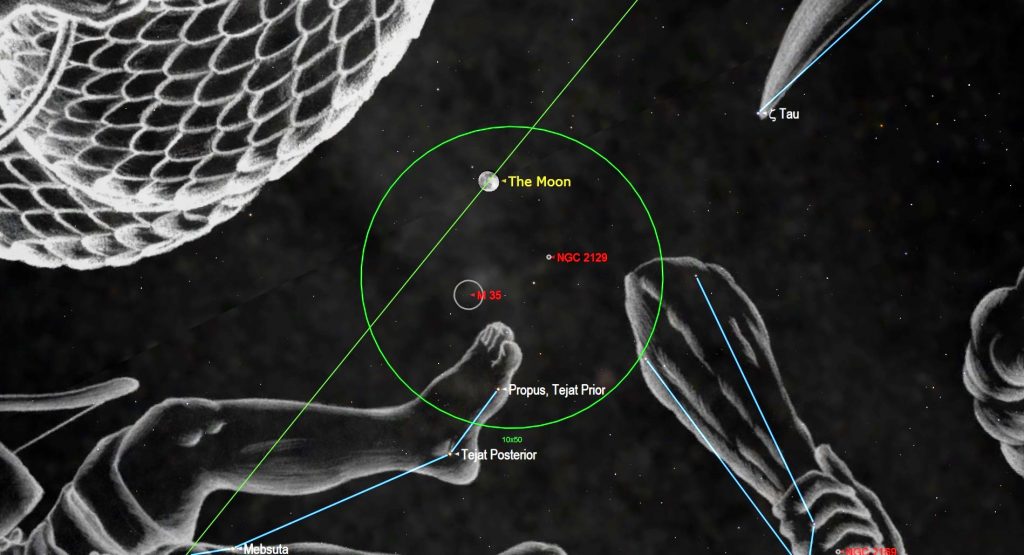
On Monday and Tuesday night the moon will cross through the rest of Gemini. On Wednesday night, the moon will be shining several finger widths to the upper left (or 3 degrees to the celestial north) of the huge open star cluster known as the Beehive, Praesepe, and Messier 44 in Cancer (the Crab). The moon and cluster, which spans twice the diameter of the moon, will be close enough to share the field of binoculars. But you’ll see more of the “bees” if you tuck the moon just out of sight on the upper left.
For the balance of this week, the moon will traverse the bright stars of Leo (the Lion). The moon will officially reach its third quarter phase at 7:27 am EST, or 12:27 Greenwich Mean Time, on Saturday morning. At third quarter our natural satellite always appears half-illuminated, on its western side – towards the pre-dawn sun. It rises in the middle of the night and remains visible in the southern sky all morning. The name for this phase reflects the fact that the moon has completed three quarters of its orbit around Earth, measuring from the previous new moon.
The Planets
The scene is being set for a grouping of three bright planets in the southwestern sky after sunset during the middle part of December! For now, extremely bright Venus is positioned about four fist diameters to the lower right (or 39° to the celestial west) of bright Jupiter – with fainter Saturn between them. Venus’ eastward orbital motion with respect to the background stars will continue until December 18. Meanwhile, the two gas giant planets are being carried west and sunward by Earth’s orbital motion. So the trio of planets will decrease their separation nightly.
This week, brilliant Venus will shine low in the south-southwestern sky after sunset, and then set at about 7:30 pm local time. You might need to walk around to find a view of the planet between the trees or buildings after sunset. Viewed in a telescope, Venus will appear less than half-illuminated, on its sun-facing side. Aim your telescope at Venus as soon as you can spot the planet in the sky (but ensure that the sun has completely disappeared first). That way, the planet will be higher and shining through less distorting atmosphere – giving you a clearer view of it. A light sky will also allow Venus’ shape to be seen more readily. The planet will grow in size and wane in phase every week for the rest of this year because Venus will be traveling into the space between Earth and the sun.
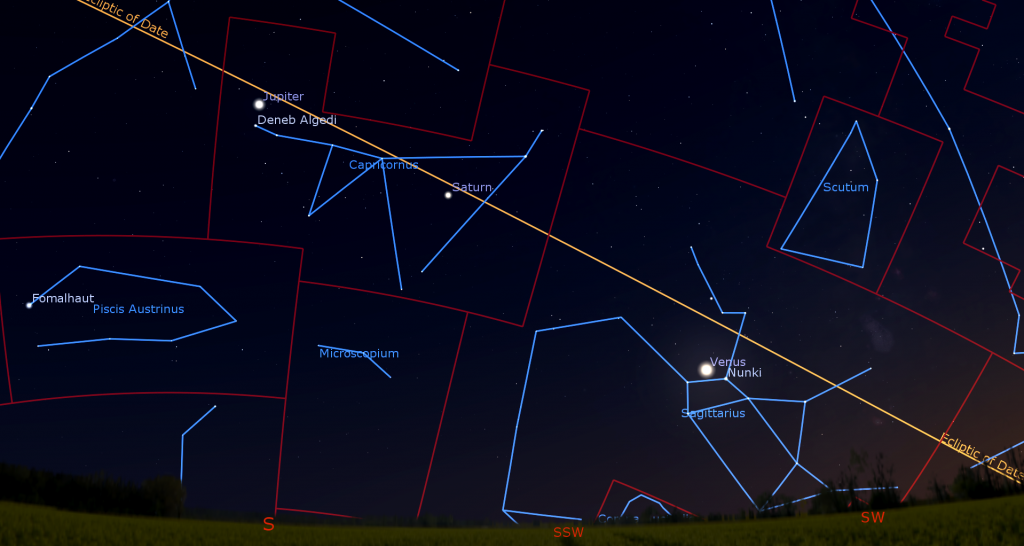
Jupiter and Saturn, parked at the opposite ends of the constellation of Capricornus (the Sea-Goat), will become visible a short time after dusk. Look for those planets less than a third of the way up the south-southwestern sky. You’ll need the sky to darken a little more before 18 times fainter Saturn appears. It’s 1.5 fist diameters to Jupiter’s right (or 15.5° to the celestial west). Jupiter and Saturn will set in the west, 90 minutes apart, after mid-evening – so observe each planet as early as you can spot it (before dinner, even) while it’s higher.
Saturn and its beautiful rings are visible in any size of telescope. If your optics are sharp and the air is steady, try to see the Cassini Division, a narrow gap between the outer and inner rings, and a faint belt of dark clouds encircling the planet. Remember to take long, lingering looks through the eyepiece – so that you can catch moments of perfect atmospheric clarity.
From here on Earth, Saturn’s axial tilt of 26.7° lets us see the top of its ring plane, and allows its brighter moons to array themselves all around the planet. Saturn’s largest and brightest moon Titan never wanders more than five times the width of Saturn’s rings from the planet. The much fainter moon named Iapetus can stray up to twelve times the ring width during its 80-day orbit of Saturn. The next brightest moons Rhea, Dione, Tethys, Enceladus, and Mimas all stay within one ring-width of Saturn.
During this week, Titan will migrate counter-clockwise around Saturn, moving from the upper right (celestial northwest) of Saturn tonight to the left (celestial east) of Saturn next Sunday. (Remember that your telescope will probably flip the view around.) How many of the moons can you see in your telescope?
Binoculars and small telescopes will show you the Jupiter’s four large Galilean moons named Io, Europa, Ganymede, and Callisto. Since Jupiter’s axial tilt is a miniscule 3°, those moons always look like beads strung on a line that passes through the planet, and parallel to Jupiter’s dark equatorial belts. That line of moons, and the belts, tilt as Jupiter crosses the sky. The moons’ arrangement varies from night to night. Io, for example, orbits Jupiter once every 42 hours. From one night to the next night, 24 hours has elapsed on Earth – time for Io to complete half an orbit and shift from one side of Jupiter to the other. The other Galilean moons move less rapidly, taking between 3.5 and 16.7 days to orbit Jupiter.
For observers in the Eastern Time Zone with good telescopes, the Great Red Spot (or GRS) will be visible while it crosses Jupiter after dusk tonight (Sunday), Friday, and next Sunday, and in mid-evening on Tuesday (with two shadows!) and Thursday.
From time to time, the small, round, black shadows cast by Jupiter’s Galilean moons become visible in amateur telescopes when they cross (or transit) the planet’s disk. On Sunday night, November 21 Io’s small shadow will cross Jupiter from 4:20 pm to 6:30 pm EST. On Tuesday evening November, 23, observers in the Americas can view a rare treat when the shadows of two moons traverse Jupiter, accompanied by the Great Red Spot! The show will begin when the spot and Ganymede’s shadow both appear near Jupiter’s limb at 6:15 pm EST (23:15 GMT). A few minutes before 7 pm EST (or 00:00 GMT on Wednesday), Callisto’s shadow will join them. The trio will cross for 2.5 hours, until the GRS rotates out of view and Ganymede’s shadow moves off Jupiter at 9:30 pm EST (02:30 GMT). Callisto’s shadow will complete its crossing at 10:45 pm EST (03:45 GMT). This event will begin during evening twilight on the west coast.
On Sunday evening, November 28, observers in the Americas can watch the small, black shadow of Jupiter’s moon Io move across Jupiter’s disk, accompanied by the Great Red Spot! The pair will begin to cross at 6:20 pm EST, or 23:20 GMT. The transit will last for approximately 2 hours. For observers in the western USA and Canada, only the later stages of the event will be occurring in a dark sky.
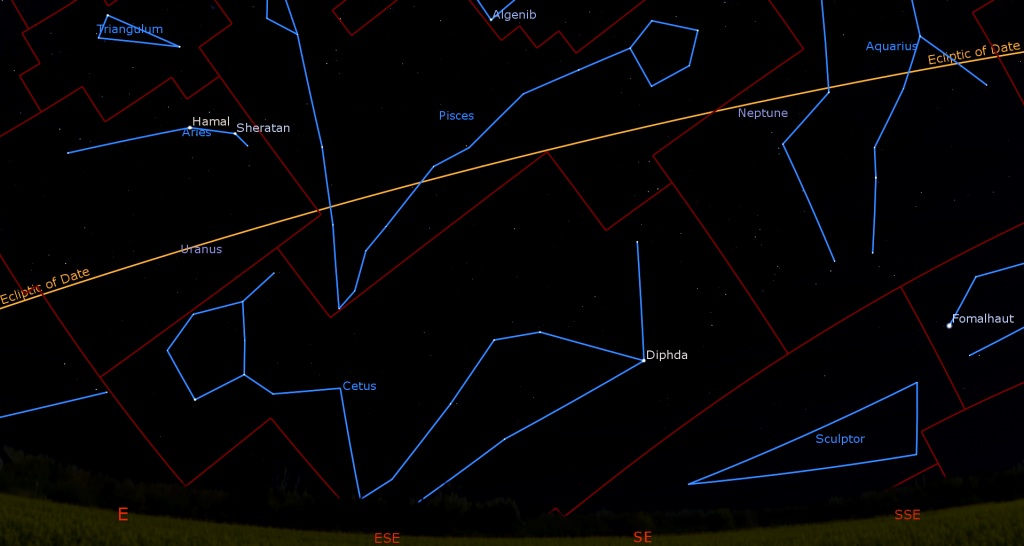
Distant, dim Neptune is in the evening sky – near the border between Aquarius (the Water-Bearer) and western Pisces (the Fishes). The magnitude 7.86 planet is also 2.5 fist diameters to the upper left (or 26° to the celestial east) of Jupiter. If the sky is very dark, Neptune can be seen in good binoculars. To locate it, find the up-down grouping of five medium-bright stars Psi, Chi, and Phi Aquarii (or ψ, X, and φ Aqr). Neptune’s non-twinkling speck will sit several finger widths to the left (or 3 degrees to the celestial NNE) of the top star, Phi. Viewed in a telescope, Neptune’s apparent disk size will be 2.3 arc-seconds. Your best views will come in mid-evening, when the blue planet is highest in the southern sky.
Uranus is shining at magnitude 5.66, still close to its early November peak in brightness. Look for the planet’s small, blue-green dot moving slowly retrograde westwards in southern Aries (the Ram), a fist’s width below (or 11.5 degrees southeast of) that constellation’s brightest stars, Hamal and Sheratan. Or use binoculars to locate Uranus using the nearby star Mu Ceti. It’s also about 1.6 fist diameters to the upper right (or 16 degrees to the celestial west-southwest) of the Pleiades star cluster. This week Uranus will be observable all night long – especially around 11 pm local time, when it will have climbed more than halfway up the southeastern sky..

Mercury is too close to the sun to be visible this week. After it passes solar conjunction on the coming weekend, it will re-appear in the southwestern evening sky towards the end of December. Meanwhile, Mars will be increasing its angle from the sun – just beginning its year-long journey to a bright showing at opposition in December, 2022. You might spot the magnitude 1.6 planet shining very low in the east-southeastern sky just after it rises at around 6 am local time, especially if you live at a tropical latitude. Our odds of successfully spotting it will improve on each subsequent morning. Take care to turn optics away from the eastern horizon well before the sun rises. If you do use some magnification on Mars on Monday morning, look for the double star Zubenelgenubi of Libra (the Scales) sitting just above Mars. Mars and the dual stars will still be telescope-close on Sunday and Tuesday, too – with the small, 3.7 arc-seconds-wide disk of Mars perched above them on Sunday and well below them on Tuesday.
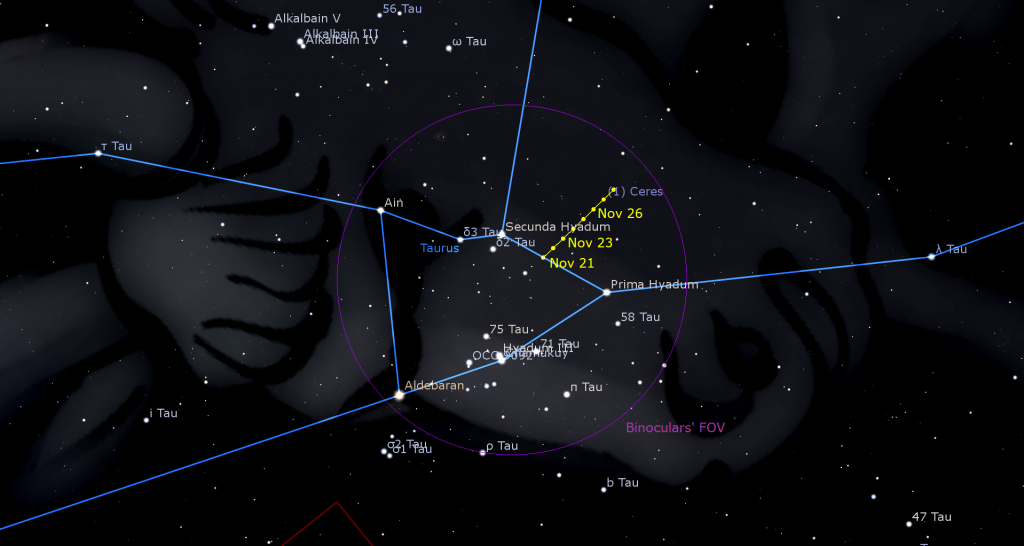
On Saturday, the dwarf planet Ceres will reach opposition, its closest approach to Earth for the year – a distance of 263 million km or 14.6 light-minutes. On the nights around opposition, Ceres will shine with a peak visual magnitude of 7, well within reach of binoculars and backyard telescopes. As a bonus, Ceres will be situated only a thumb’s width above (or 1.4 degrees to the north of) the bright star that marks the chin of the bull, Gamma Tauri. Both objects, and the rest of Taurus’ triangular face, will easily fit within the field of view of binoculars. Ceres will already be climbing the eastern sky after dusk. It will reach its highest elevation, and peak visibility, over the southern horizon at about midnight local time.
The Brightest Stars of November
The brightest constellations of the year have returned to the evening sky – with many of them containing two or more very bright stars. Meanwhile, quite a few of the brightest summer stars are still around because the earlier sunsets are keeping them in view, even as they shift towards the sun. Some call this “the Summer Triangle effect”. (Conversely, every spring the later sunsets shorten our viewing time for the spring constellations – and the galaxies that they host.)
Bright stars remain easy to see on moonlit nights, even under mildly light-polluted skies. Once Sirius has risen in the southeast just before 11 pm local time, 16 of the top 30 brightest stars in the entire night sky become visible to observers at mid-northern latitudes worldwide. Let’s tour the brightest ones. I’ve put their brightness rankings (not counting the sun) in parentheses.
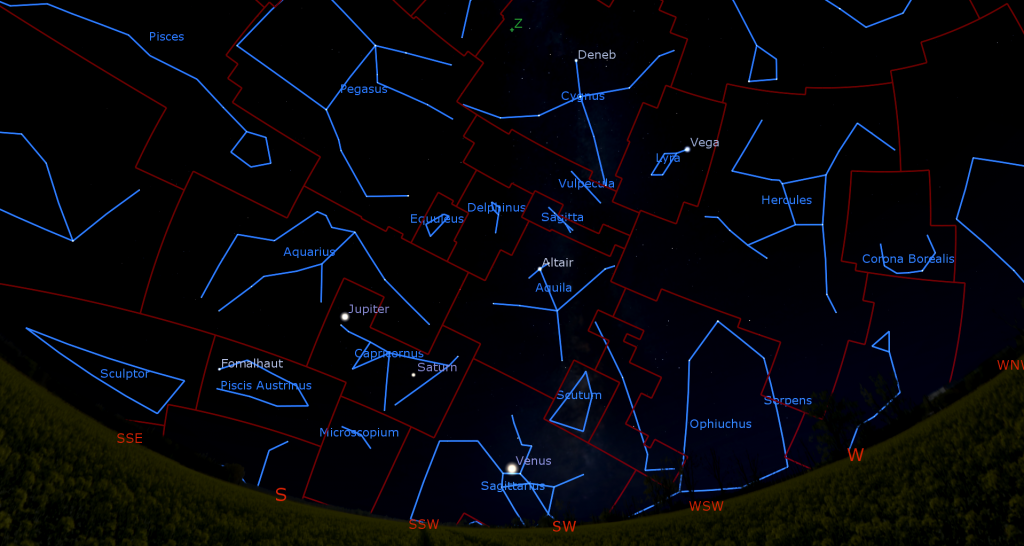
Even before the sky has fully darkened this week, look high in the western sky for the three bright, white stars of the Summer Triangle. Despite their name, those stars will continue to be visible until mid-January! During mid-evening, the very bright, magnitude 0.0 star Vega (5th) in Lyra (the Harp) will shine about halfway up the northwestern sky. Altair (12th) in Aquila (the Eagle) will be slightly lower and off to Vega’s left (or celestial south) – preparing to set at about the same time that Sirius rises. More than two fist diameters above and between Vega and Altair, in Cygnus (the Swan) you’ll find Deneb (19th).
Vega is the reference point for the brightness scale. Magnitude values greater than 0.0 are fainter than Vega. Objects with negative magnitude values shine brighter than Vega. A single integer jump in value (either up or down) translates to a 2.5 times difference in visual brightness.
Turning to face south, mid-northern latitude observers with a low southern horizon should be able to see Fomalhaut (18th) in Piscis Austrinus (the Southern Fish). Big telescopes have been able to take pictures of a dusty protoplanetary disk that encircles Fomalhaut. People living at more southerly latitudes get to see Fomalhaut higher in their sky. This year, 10 times brighter Jupiter will shine to Fomalhaut’s upper right.
The rest of the brightest stars are in the eastern sky after mid-evening. Yellowish Capella (6th), in Auriga (the Charioteer) is the brightest and highest of the eastern sky’s bright lights. Although it is circumpolar (i.e., it never sets) for mid-latitudes, it doesn’t tend to climb higher than landscape obstacles until after 6 pm local time. Reddish Aldebaran (14th), which marks Taurus the bull’s southern eye, is located three fist diameters to the lower right (or 30 degrees to the celestial south) of Capella. It’s rising by 6 pm local time this week. Magnitude 1.65 Elnath (27th) is the star at the opposite side of Auriga’s ring from Capella and also serves as Taurus’ upper horn tip.
The next very bright star to rise, at about 7:30 pm local time, will be orange-red Betelgeuse (normally 10th). This red giant marks the eastern shoulder, or armpit, of Orion (the Hunter). During the winter of 2019-2020 Betelgeuse dimmed dramatically, lowering its ranking for a while. Orion’s other shoulder, the star Bellatrix (26th), will rise half an hour before Betelgeuse.

Castor (24th), which marks the head of the western (and higher) sibling of Gemini (the Twins) will appear around the same time as Orion’s shoulders, but is located several fist diameters off to their left. Castor is positioned about three fist diameters below (or 30 degrees to the celestial southeast of) Capella. The star sitting about four finger widths below Castor is Pollux (17th). To help you remember which is which, note that Castor comes first in an alphabetical list and also rises before Pollux. Despite them being “twins”, Pollux is somewhat brighter and warmer in colour than Castor. Castor is a fantastic multiple star easily visible in backyard telescope.
Around the time that Pollux rises, blue-white Rigel (7th), which marks the western foot of Orion, will appear over the east-southeastern horizon. Then we have to wait 90 minutes for the next bright star to appear – Procyon (8th), in Canis Minor (the Little Dog). It’s below and between Gemini and Orion. While you wait, take a few minutes to appreciate the three stars in Orion’s Belt. From bottom to top (or celestial east to west), they are Alnitak (33rd), Alnilam (29th), and Mintaka (67th). Alnilam is 2000 light-years away from us, compared to the other two, which are half as far away.
Our last bright stars to rise are part of Canis Major (the Big Dog). The “Dog Star” Sirius (1st) will be hard to miss once it rises at about 10 pm local time. The star will climb to its highest point, about a third of the way up the southern sky, at 2 am local time. If you are walking through your darkened house in the middle of the night, this star might catch your eye out a south-facing window because it never climbs very high. Sirius’ brightness and low position in the sky combine to produce spectacular flashes of colour as it twinkles. Finally, after 11 pm, the stars Adhara (22nd) and Wezen (36th) will appear below Sirius. They marks the dog’s rear leg and rump, respectively, and gives this little constellation three bright stars.
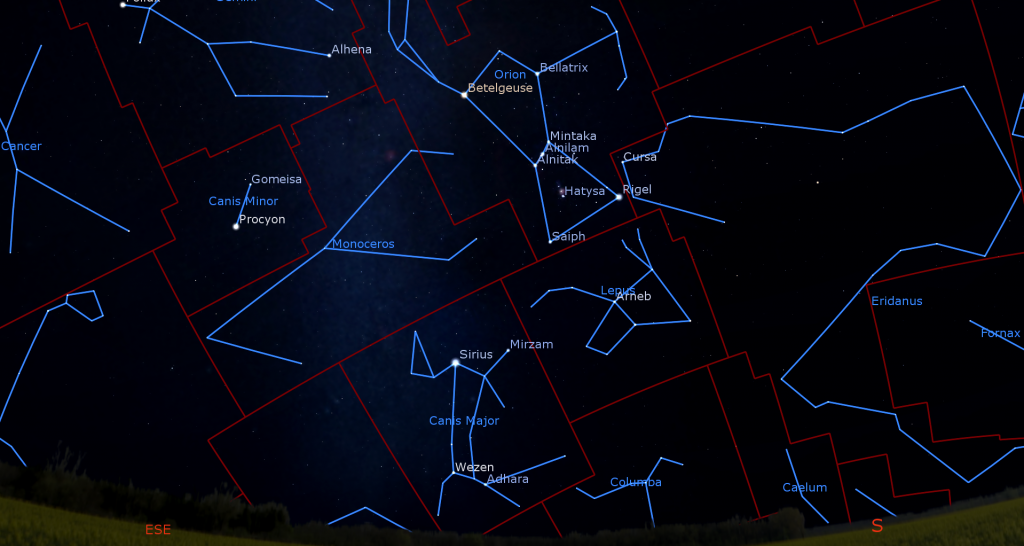
Stars appear brighter for two primary reasons. They can be inherently more luminous (i.e., emitting more visible light) and/or they can be closer to us. Two of the stars noted above, Sirius and Procyon, are only about 10 light-years away from our sun. Vega, Altair, Pollux, and Fomalhaut are less than a few dozen light-years away. Betelgeuse is 640 light-years away. Amazingly, Deneb is a whopping 2,600 light-years away! It’s producing a prodigious amount of visible light to appear so bright from such a distance!
With each week that rolls by, these stars rise about half an hour earlier. Enjoy!
Public Astro-Themed Events
Every Monday evening, York University’s Allan I. Carswell Observatory runs an online star party – broadcasting views from four telescopes/cameras, answering viewer questions, and taking requests! Details are here. Their in-person Wednesday night viewing has been converted to online via the observatory YouTube channel.
My free, family-friendly Insider’s Guide to the Galaxy webcasts with Jenna Hinds of RASC National returns on Tuesday, November 23 at 3:30 pm EST, when we’ll cover holiday gift ideas and the most useful astronomy accessories. You can find more details and the schedule of future sessions here.
On Thursday night, November 25 from 7 to 9 pm EDT, SkyNews Magazine and the Royal Astronomical Society of Canada will present Exoplanet Hunting From Home, their latest free online speakers series presentation. Laurie Sibbald will discuss how he detects exoplanets from the suburbs, using everyday equipment. Details are here, and the registration link is here.
On Friday, November 26 at 7:30 pm EST, the RASC Mississauga Centre will livestream their Speaker Night, featuring my 110 Things to See With a Telescope book co-author John A. Read. The Zoom registration link and details are here.
RASC’s in-person sessions at the David Dunlap Observatory may not be running at the moment, but they are pleased to offer some virtual experiences instead, in partnership with Richmond Hill. The modest fee supports RASC’s education and public outreach efforts at DDO. On Sunday afternoon, November 28 from 12:30 to 1 pm EST, tune in for DDO Sunday Sungazing. Safely observe the sun with RASC, from the comfort of your home! During these family-friendly sessions, a DDO Astronomer will answer your questions about our closest star: the sun! Learn how the sun works and how it affects our home planet. Live-streamed views of the sun through small telescopes will be included, weather permitting. Only one registration per household is required. Deadline to register for this program is Wednesday November 24, 2021 at 3 pm. Prior to the start of the program you will be emailed information on the virtual program links and any specific information relating to your program. The registration link is here.
Don’t forget to take advantage of the astronomy-themed YouTube videos posted by RASC Toronto Centre and RASC Canada.
Keep looking up, and enjoy the sky when you do. I love questions and requests. Send me some!